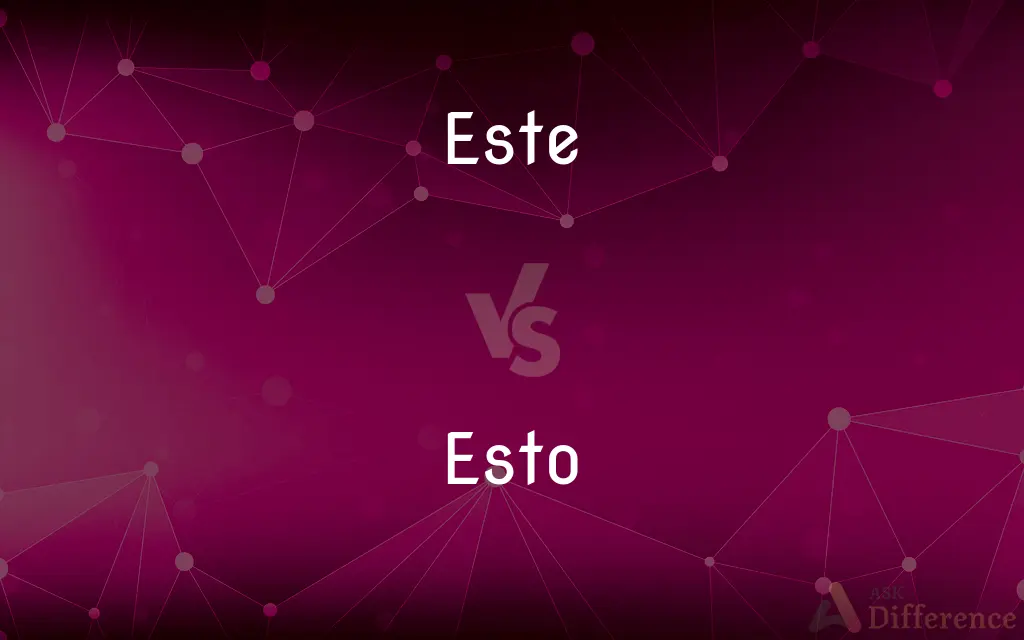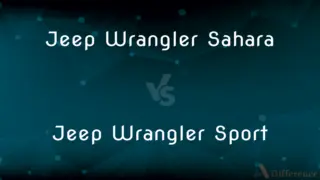Este vs. Esto — What's the Difference?
By Urooj Arif & Fiza Rafique — Published on March 6, 2024
"Este" is demonstrative adjective used to describe a masculine noun close to the speaker (e.g., "este libro" for "this book"). "Esto" is a neuter demonstrative pronoun used for unspecified or abstract things (e.g., "¿Qué es esto?" for "What is this?).

Difference Between Este and Esto
Table of Contents
ADVERTISEMENT
Key Differences
"Este" is used in Spanish as a demonstrative adjective that agrees in gender with the noun it describes, specifically for masculine nouns that are physically or contextually near the speaker. For instance, saying "este coche" refers specifically to "this car" that is close by. On the other hand, "esto" serves as a neuter demonstrative pronoun, used when the gender of the noun is unknown, not applicable, or when referring to a general situation or abstract concept, as in "esto es importante" meaning "this is important."
"Este" always precedes and agrees with a masculine noun, modifying it directly, while "esto" can stand alone or refer back to a previously mentioned or understood concept without directly modifying a noun. This difference highlights the specific vs. general or abstract usage of these terms.
The choice between "este" and "esto" depends on the presence and gender of the noun in question. "Este" is selected for specific, masculine nouns ("este libro"), whereas "esto" is chosen for situations where the noun is not mentioned or its gender is irrelevant ("esto no funciona" meaning "this does not work").
In terms of usage, "este" points out a particular item or concept in a way that is more defined and concrete, requiring a clear, masculine noun to modify. "Esto," however, is used in a broader sense, often in philosophical or reflective statements, where the exact nature of what is being referred to is left undefined or is abstract.
Understanding the difference is crucial for Spanish learners to ensure accurate communication, especially in contexts where the distinction between specific and general, or concrete and abstract, matters. Misusing "este" and "esto" can lead to confusion or ambiguity in speech or writing.
ADVERTISEMENT
Comparison Chart
Type
Demonstrative adjective
Neuter demonstrative pronoun
Gender Agreement
Masculine
Neuter (no gender)
Usage with Nouns
Used with specific, masculine nouns
Used without a noun for general or abstract concepts
Function in a Sentence
Modifies a noun directly
Stands alone or refers to an unspecified or abstract concept
Example Usage
"Este libro es mío." (This book is mine.)
"¿Qué es esto?" (What is this?)
Compare with Definitions
Este
Agrees in gender with the noun it modifies.
Este perro es amigable. (This dog is friendly.)
Esto
Neuter demonstrative pronoun for abstract concepts or unspecified things.
Esto es increíble. (This is incredible.)
Este
Indicates proximity or relevance.
Este día es importante. (This day is important.)
Esto
Does not modify a noun directly.
Esto me preocupa. (This worries me.)
Este
Demonstrative adjective for masculine nouns near the speaker.
Este coche es nuevo. (This car is new.)
Esto
Stands alone without accompanying a noun.
Esto es lo que pienso. (This is what I think.)
Este
Used to specify a particular item or idea.
Este momento es perfecto. (This moment is perfect.)
Esto
Used when gender is not known or not applicable.
¿Qué es esto? (What is this?)
Este
Part of the trio este, esta (feminine), estos, estas (plural).
Este hombre, esta mujer, estos niños. (This man, this woman, these children.)
Esto
Refers to situations or ideas rather than specific objects.
Esto cambia todo. (This changes everything.)
Este
Alternative form of est
Common Curiosities
Can "esto" be used to refer to a specific object?
No, "esto" is used for unspecified objects, abstract concepts, or when the gender of the noun is not known.
Can "este" modify a feminine noun?
No, "este" is specifically for masculine nouns; "esta" is used for feminine nouns.
Can "este" and "esto" be used interchangeably?
No, their usage depends on the specificity and gender of the noun in question.
How does gender affect the use of "este"?
"Este" is used with masculine nouns, while its feminine counterpart is "esta."
What is the plural form of "este"?
The plural form of "este" is "estos" for masculine nouns and "estas" for feminine nouns.
Is "esto" ever used with a noun?
No, "esto" stands alone and does not directly modify a noun.
How does context influence the use of "este" vs. "esto"?
The context, including proximity, specificity, and gender of the noun, determines whether "este" or "esto" is appropriate.
When do you use "este" in a sentence?
Use "este" when referring to a specific, masculine noun that is near the speaker.
Is there a plural form for "esto"?
No, "esto" is invariant and does not have a plural form as it refers to abstract concepts or unspecified things.
What is an example of "esto" in a question?
"¿Qué es esto?" is a common question format using "esto" to inquire about an unknown or unspecified item.
Why is it important to distinguish between "este" and "esto"?
Proper use of "este" and "esto" ensures clarity in communication, accurately conveying specificity and gender.
Does "este" have any other forms besides "estos"?
Yes, "este" (masculine singular), "estos" (masculine plural), "esta" (feminine singular), and "estas" (feminine plural) are all forms.
How do you decide between using "este" or "esto"?
Choose "este" for specific, masculine nouns near you, and "esto" for general or abstract references.
What is a mistake to avoid when using "este" and "esto"?
Avoid using "este" with feminine nouns or "esto" to refer to specific, gendered nouns.
Can "esto" refer to a previously mentioned concept?
Yes, "esto" can refer back to a concept or idea discussed earlier without specifying its nature.
Share Your Discovery

Previous Comparison
Jeep Wrangler Sahara vs. Jeep Wrangler Sport
Next Comparison
5w30 vs. 10w30Author Spotlight
Written by
Urooj ArifUrooj is a skilled content writer at Ask Difference, known for her exceptional ability to simplify complex topics into engaging and informative content. With a passion for research and a flair for clear, concise writing, she consistently delivers articles that resonate with our diverse audience.
Co-written by
Fiza RafiqueFiza Rafique is a skilled content writer at AskDifference.com, where she meticulously refines and enhances written pieces. Drawing from her vast editorial expertise, Fiza ensures clarity, accuracy, and precision in every article. Passionate about language, she continually seeks to elevate the quality of content for readers worldwide.












































